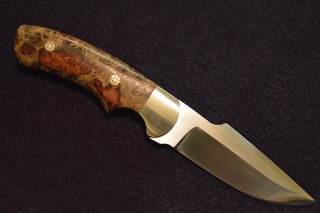If doing domed pins, or a slipjoint pivot, I use a hammer, it takes me seconds, no rigging, nothing complicated, and no other method I've found gives the same results, or gives you the latitude to work with the various angles of radiused handle material, or odd spots like the depths of stag. On the other hand, for pinning bolsters for fixed blades, with hidden pins, I use my bench vise to squeeze them. You have to have a good solid vise without a lot of wiggle, and a decent sized one that has a lot of pressure, but it's quick, and foolproof once you figure it out.
You have to learn how much pin stick-out, and it works easiest with 3/32 or larger pins, 1/8" is better. Leave the pins sticking out less than the pin diameter, make sure you grind them square, stick the bolsters on, pin in, put it between the vise jaws, and crank it down as hard as you can (if you have a really large vise, use discretion and don't crank it too hard or you'll mar the bolsters). Grind the heads off and you're done. If everything was flat, it should be extremely tight and the pins will hide perfectly.
One thing that's really really important with hiding pins: you need clean pin holes, without burrs or a bunch of chatter inside. Use a tapered pin reamer to ream the holes, by hand. You can use a small tap wrench, pin vise, or graver holder to hold the reamer, get one that fits comfortably inside the hole without bottoming, and turn a few turns by hand, and then look closely with an optivisor inside the hole to be sure it's clean. Your pin stock must be clean (bright finish is optimal) also. Once you're comfortable with it, it takes only a second per hole, and you'll know without looking, by feel, when it's right.







